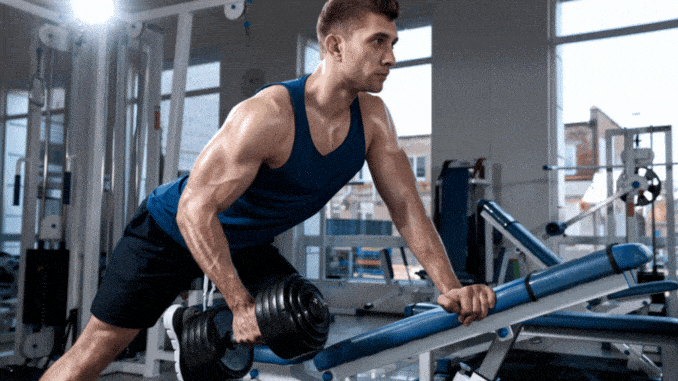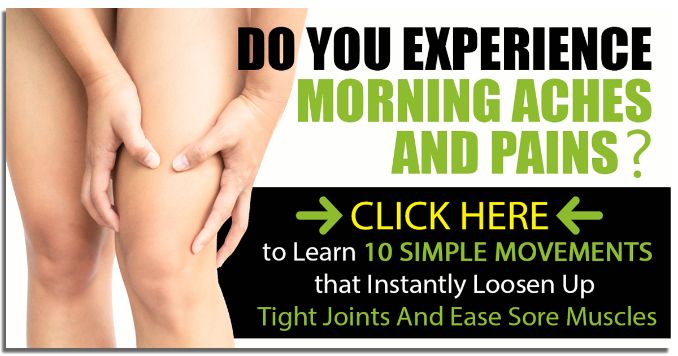Hey, Jedd Johnson here from DieselCrew.com. I had many people recently talk to me about wrist and elbow pain | 404 when doing straight bar work. So, what we’re doing today is the bent-over row exercises.
The bent-over row is among the most effective exercises for building strength in your upper back and arms. Whether you’re a beginner or more advanced, you can perform this exercise using either dumbbells or a barbell, depending on your fitness level.
Both options provide great versatility, allowing you to adjust the resistance for optimal results. It’s also a great exercise for your middle and lower back. But most importantly, the bent-over row is an excellent way to prevent back pain.
This exercise is also a great way to hit your back, biceps, and core muscles. They’re also one of the most effective exercises for strengthening your lower body (quadriceps and hamstrings).
For those aiming to improve strength, build muscle mass, or lose fat, the bent-over row is an excellent exercise choice. Its versatility makes it perfect for achieving multiple fitness goals, whether focusing on increasing power or enhancing overall body composition.
The bent-over row is one of the best exercises a person can do to build a powerful back. It’s also an excellent calorie-burning exercise, targeting the entire back and upper and lower body muscles.
However, not everyone can perform this exercise because it requires a certain amount of hamstrings and spinal flexibility. With that said, there are some variations that anyone can perform to get the same benefits without risking injury.
But what if you can’t do bent-over rows?
Don’t worry! There are two pain-free alternatives that you can use instead that will get the same results. Here are two painless alternatives you should try out if you’re struggling with the basic bent-over row.
1. Bent-over Row Using Globe Gripz
Bent-over Row Using Globe Gripz
To get started, attach the Globe Gripz to a barbell.
- Start this Bent-over Row Exercises by standing upright in front of a barbell with your feet positioned wider than hip-width apart, ensuring your head, shoulders, hips, and legs are properly aligned.
- Next, grip the barbell with your hands shoulder-width apart.
- Engage your core for stability, then hinge at the hips to lower your upper body forward while maintaining a straight back.
- As you pull the weight up toward your lower chest or ribs, focus on squeezing your shoulder blades together and keeping your elbows close to your sides.
- Slowly lower the weight back down with control, and repeat the movement, maintaining good form throughout.
Important Reminder
The Globe Gripz will make it harder to hold the weight, so start with lighter weights than usual to get used to the extra grip challenge.
The bent-over row strengthens the muscles of your back and hamstrings. It’s a great way to target these muscle groups for an effective overall workout. The bent-over row exercise can also help improve posture [1], balance, and stability and prevent or alleviate back pain.
Globe Gripz has made this exercise easier than ever before! Globe Gripz is designed to enhance your grip on weights with its innovative design, eliminating the need for chalk or additional grips. By simply snapping it onto the bar, you’ll experience better control during your workouts. Try them today and feel the difference they can make in your training routine!
I’ve personally tried Globe Gripz, and I can confidently say it’s a great option for you. It easily snaps onto the bar, making it super convenient to use!
What bothers me is the position of the straight bar. It tends to pull my wrist and force me into full supination with my palm facing upward, which isn’t ideal. To avoid discomfort, I steer clear of that position. However, the Globe Gripz offers a solution by placing me in a slight supination instead of an extreme one, making it much more comfortable and manageable for my wrists.
2. Bent-over Row Using BackBull
Bent-over Row Using BackBull
Start by attaching the BackBull handle to a barbell.
- Start this Bent-over Row Exercises by standing upright in front of a barbell with your feet positioned slightly wider than hip-width apart.
- Ensure proper alignment throughout your body, including your head, shoulders, hips, and legs.
- Next, engage your core muscles to stabilize your posture.
- Gently soften your knees and hinge at the hips, leaning your upper body forward while keeping your back straight.
- Once in this position, grasp the BackBull handles with both hands and pull the bar toward your lower chest, squeezing your shoulder blades together as you lift.
- Slowly lower the bar back down with control.
- Relax briefly, then repeat the movement, paying close attention to maintaining proper form throughout.
Important Reminder
Ensure the movement remains smooth and controlled, avoiding any swinging or jerking of the weight. Additionally, be mindful not to round your back at any point. Instead, focus on engaging your back muscles to lift the weight rather than relying on your arms. This will help you maintain proper form and prevent injury.
The bent-over row is a weight-training exercise that primarily targets the muscles in the back of the upper body. The bent-over row can be completed using a barbell or dumbbell [2]. Here, you will find detailed instructions on how to perform a bent-over row using a back bull. The guide includes pictures and step-by-step instructions to help you execute the exercise correctly. Additionally, we’ll walk you through each phase to ensure proper form and technique for optimal results.
A back bull is used for this exercise because it resembles the shape of an actual back. It also offers comfort and stability when performing this exercise, especially if you’re prone to low back pain, discomfort, or injury.
I have another alternative tool that works well, called the Master the Bent Over Row: Good Form and Variations. It will move you even further out of that extreme supinated position. There are two options, which are slightly supinated or slightly pronated. Do what is more comfortable for you. Approach the bar, snap the hook, then perform the rows.
Both of these allow you to get good quality back work into your routine. It tests your grip but doesn’t test your range of motion | 404. Let me know if you feel better, have more intense workouts, and optimize your gains when doing bent-over row exercises. I hope this video has been helpful.
Why These Variations Are Important for Injured Athletes
As an athlete, your body is your most important tool, and training with pain or injury can make things worse.
Aside from Bent-over Row Using Globe Gripz and Bent-over Row Using BackBull, doing other exercises is also helpful.
Each bent over row alternative allows you to keep training while avoiding further damage to your joints or back. Here are some of them.
Bent Over Row Alternatives
Remember to keep good posture (proper form) and make sure your body is in a straight line during each exercise to get the best results.
Barbell Row Options:
- Barbell Row
- This foundational move is essential for building back strength. To perform it correctly, keep your back straight as you pull the barbell toward your chest. As you lift, focus on maintaining a straight line throughout your body to ensure proper form and maximize the exercise’s effectiveness.
- Bent-Over Barbell Row
- Begin by bending at your hips while keeping your back flat. Position yourself correctly with your chest leaning slightly forward. From this starting position, pull the barbell up toward your ribs, ensuring that you maintain good form throughout the movement.
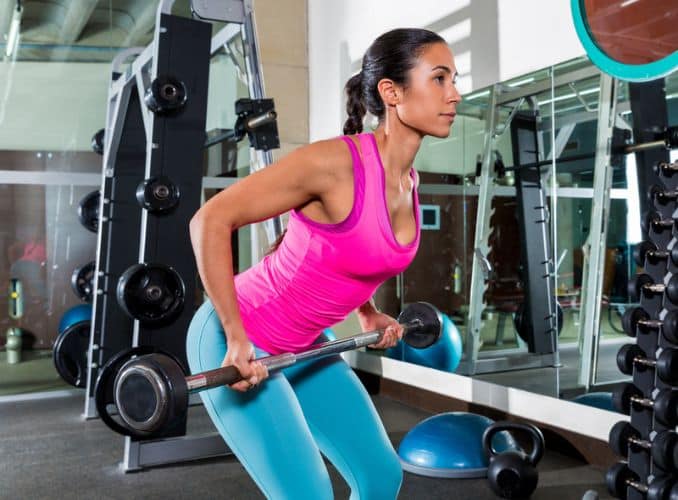
Bodyweight and Band Exercises:
- Pull-Ups
Pull-ups are great for working your upper back. Start by hanging from a bar with your body in a straight line. Pull yourself up until your chin is above the bar, making sure to keep proper form. - Inverted Row
This is a great bodyweight option that’s easier on your joints. Set up a bar at waist height or use straps. Lie under the bar with your body in a straight line and pull yourself up toward the bar. - Resistance Band Row
Using a resistance band is a gentle, joint-friendly option. Start by holding the band in front of you, keeping your back in a straight line, and pull it toward your body.
Other Simple Alternatives:
- Single-Arm Dumbbell Row
This move focuses on one side of your back at a time. Start by placing one knee and hand on a bench. Keep your back in a straight line and pull the dumbbell up toward your hip, making sure to use proper form. - Seated Cable Row
This machine is adjustable, making it easy to find the right weight. Sit with your back straight and pull the handle toward you slowly, keeping good posture and using proper form. - Chest-Supported Machine Row
This machine supports your chest, so you don’t have to bend over. Just sit down and pull the handles toward you, keeping your back in a straight line. - Incline Dumbbell Row
Lie face-down on an incline bench and pull the dumbbells toward your body. This position takes pressure off your lower back and helps you keep proper form easily. - T-Bar Row
The T-bar row allows for a comfortable grip. Start by holding the bar with both hands and pull it toward your chest, keeping your body in a straight line to avoid any strain.
These exercises are easy to include in your workout routine, and by keeping proper form, you’ll be able to avoid pain and build a strong back. However, even with the best preparation, injuries can still occur, especially for athletes who push their bodies to the limit.
4 Common Athlete Injuries

***The case studies did not disclose the names to maintain the privacy and confidentiality of the individuals involved***
1. Rotator Cuff Tear
Athletes involved in overhead sports like baseball, tennis, and swimming are at a higher risk of rotator cuff injuries.[3]
- Symptoms: Pain in the shoulder, especially when lifting or lowering the arm. Weakness or instability in the shoulder. A cracking sensation when moving the shoulder. Difficulty with daily activities (e.g., reaching behind the back).
- Causes: Repetitive stress (e.g., throwing motions in baseball or swimming). Acute injuries, such as falling on an outstretched arm. Aging leads to degeneration of the rotator cuff muscles.
- Treatment Options:
- Non-Surgical: Physical therapy, anti-inflammatory medication, rest, and ice.
- Surgical: In severe cases, arthroscopic surgery may be recommended.
- Prevention Tips: Strengthen the shoulder muscles through shoulder presses, lateral raises, and internal/external rotation exercises.
“Rotator cuff injuries are common among athletes, especially those involved in overhead sports… It’s important to tailor the treatment plan to the athlete’s specific needs and sport to ensure a successful recovery and return to play” ~ Michael Erickson, MD, Sports Medicine Physician [4]
- Case Study [5]: An elite-level 23-year-old female tennis athlete with a high-grade partial thickness tear of the supraspinatus experienced significant pain and dysfunction. After undergoing 24 physical therapy sessions focusing on a regional interdependence approach, she saw improvements in pain, mobility, strength, and function, allowing her to return to elite-level play.
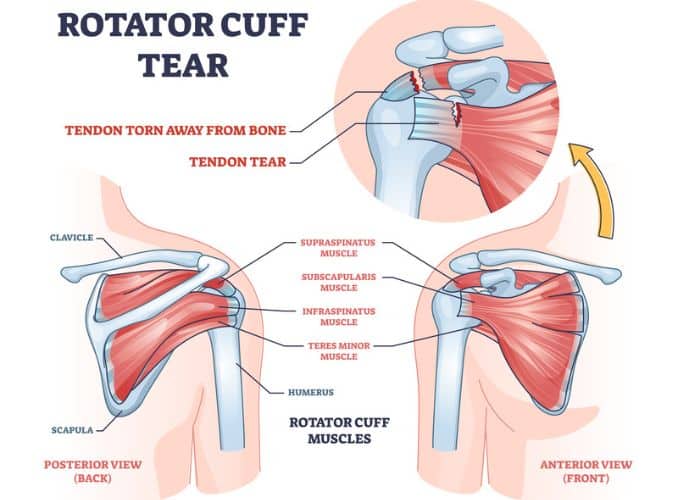
2. Anterior Cruciate Ligament (ACL)
ACL tears [6] are one of the most feared injuries among athletes, particularly in sports involving sudden stops and changes in direction, such as soccer, basketball, and skiing.
- Symptoms: A loud “pop” sound in the knee at the time of injury. Severe pain and rapid swelling. Inability to continue activity. Instability or giving way of the knee during weight-bearing.
- Causes: Sudden pivoting or changing direction. Landing awkwardly from a jump. Direct impact to the knee in contact sports.
- Treatment Options:
- Non-surgical: Rest, physical therapy, bracing, and rehabilitation exercises.
- Surgical: ACL reconstruction surgery, followed by 6-12 months of rehabilitation.
- Prevention Tips: Focus on knee-strengthening exercises, particularly targeting the quadriceps and hamstrings. Include balance training and plyometrics to improve body control. Warm up thoroughly before sports and incorporate agility drills.
Dr. Greg Schaible [7] emphasizes the importance of proper technique and conditioning to prevent ACL injuries, particularly in non-contact situations. He highlights that learning to move and land safely is crucial for injury prevention.
- Case Study [8]: This case discusses an English Premier League football player who managed to return to play in less than 8 weeks without undergoing surgery. The player followed a rigorous rehabilitation program that included physical therapy and specific exercises tailored to his needs. His recovery was closely monitored, and he was able to return to his sport successfully.
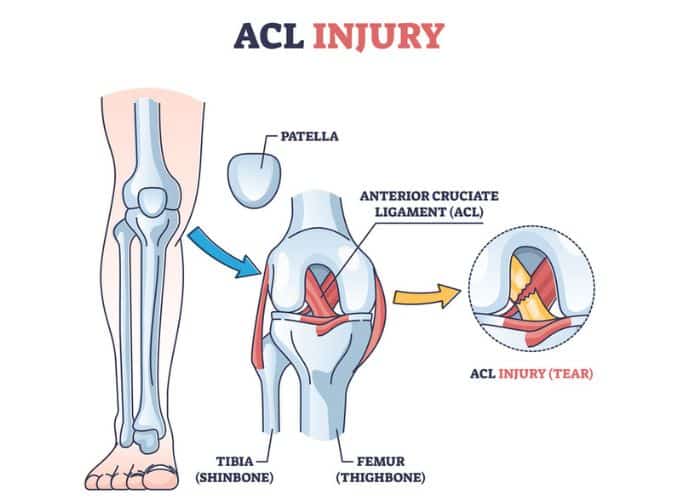
3. Tennis Elbow (Lateral Epicondylitis) [9]
Tennis elbow is an overuse injury causing pain on the outer part of the elbow, common in tennis players and anyone performing repetitive gripping or wrist-extension activities.
- Symptoms: Pain or burning sensation on the outside of the elbow. Weak grip strength. Discomfort when performing basic tasks, such as shaking hands or lifting objects.
- Causes: Overuse of forearm muscles due to repetitive motion (e.g., tennis, painting, typing). Poor technique in activities like racket sports or manual labor.
- Treatment Options:
- Non-surgical: Rest, ice, non-steroidal anti-inflammatory drugs (NSAIDs), physical therapy, and stretching/strengthening exercises.
- Surgical: Rarely required, but may be considered if symptoms persist for over a year despite conservative treatment.
- Prevention Tips: Ensure proper technique in sports that involve wrist movement. Strengthen the forearm muscles to reduce the risk of strain. Take breaks during repetitive tasks and use ergonomic tools when possible.
- Dr. Raman Kant Aggarwal [10] is an expert in orthopedics. He emphasizes the importance of using proper mechanics, avoiding overuse, and incorporating stretching and strengthening exercises for the forearms to prevent and recover from the tennis elbow.
- Case Study [11] A 54-year-old lawyer, an avid tennis player, experienced severe elbow pain in her dominant arm. She spent long hours at her computer, which compounded her condition. After a thorough assessment, she was diagnosed with tennis elbow, characterized by severe inflammation at the tendon attachment site on the outside of her elbow.
- Her treatment included a combination of traditional physiotherapy and Shockwave therapy. Despite the initial discomfort from Shockwave therapy, it proved to be effective. Over time, she regained full strength and became pain-free, allowing her to return to her daily activities and tennis without limitations.
- Dr. Raman Kant Aggarwal [10] is an expert in orthopedics. He emphasizes the importance of using proper mechanics, avoiding overuse, and incorporating stretching and strengthening exercises for the forearms to prevent and recover from the tennis elbow.

4. Plantar Fasciitis
Plantar fasciitis [12] is one of the most common causes of heel pain, affecting runners and people who spend much time on their feet.
- Symptoms: Sharp pain in the heel, especially when taking the first steps after waking up. Pain worsens with prolonged standing or after exercise. Tightness in the Achilles tendon or calf muscles.
- Causes: Overuse or strain on the plantar fascia ligament (e.g., running, standing for long periods). Improper footwear without proper arch support. Flat feet or abnormal walking patterns.
- Treatment Options:
- Non-surgical: Rest, ice, stretching exercises, orthotic inserts, physical therapy, and anti-inflammatory medications.
- Surgical: Rare but may be needed in chronic cases unresponsive to conservative treatments.
- Prevention Tips: Wear proper, supportive footwear, especially for activities like running or prolonged standing. Stretch the Achilles tendon and calf muscles regularly to prevent tightness. Avoid excessive running or walking on hard surfaces without proper support.
Dr. Thomas Trojian [13] is a sports medicine specialist. He emphasizes the importance of early intervention in treating plantar fasciitis, including stretching, wearing appropriate footwear, and taking rest breaks to prevent chronic pain.
- Case Study [14]: A 27-year-old male with heel pain from plantar fasciitis was treated at the Sydney Heel Pain Clinic. His treatment included stretching exercises, supportive footwear, and activity modification. Over time, these interventions significantly reduced his pain, allowing him to return to normal activities without limitations.

Injury Assessment Quiz
Disclaimer: This assessment quiz is meant to give you general advice based on your answers, but it’s not a replacement for professional medical help. The quiz can help guide you on what to do next, but it’s important to remember that it doesn’t cover all situations, and your condition may need more attention.
If you are unsure about your injury, or if you have severe pain, swelling, or other serious symptoms, please see a doctor or healthcare professional right away. The quiz results are just suggestions, and we can’t be held responsible for any choices you make about your health based only on this quiz. When in doubt, always get checked out by a medical expert!
1. Type of Pain
What kind of pain are you experiencing?
- A) Sharp and intense
- B) Dull and throbbing
- C) Mild discomfort
- D) No pain, just stiffness
2. Duration of Pain
How long have you been experiencing this pain?
- A) Less than 1 week
- B) 1-4 weeks
- C) Over a month
- D) On and off for several months
3. Movement Impact
Does your injury affect your ability to move normally?
- A) I can’t move the affected area at all
- B) I have limited movement with discomfort
- C) I can move, but it hurts slightly
- D) No, I can move normally, but I feel stiffness
4. Swelling and Inflammation
Is there visible swelling or inflammation around the injured area?
- A) Yes, it’s severe and noticeable
- B) Slight swelling
- C) No visible swelling, but it feels tender
- D) No swelling at all
5. Recent Activities
Have you engaged in activities that may have caused or worsened the injury (e.g., lifting weights, running, or sitting for long periods)?
- A) Yes, during an intense activity or workout
- B) Yes, during everyday movements like walking or bending
- C) No, it came on gradually with no specific cause
- D) I’m not sure
6. Past Injuries
Have you experienced a similar injury in the past?
- A) Yes, and it required medical attention
- B) Yes, but it healed on its own
- C) No, this is the first time
- D) Not sure
7. Pain Relief Attempts
Have you tried any home remedies or exercises to relieve the pain (e.g., rest, icing, stretching)?
- A) Yes, but they haven’t helped at all
- B) Yes, and it provided some relief
- C) No, I haven’t tried any remedies yet
- D) Yes, and it resolved the issue temporarily
Results:
Recommendations based on your responses:
A. Seek Immediate Medical Attention
- If most of your answers are “A,” it’s important to seek professional medical attention immediately. Severe pain, swelling, or the inability to move the injured area could indicate a serious condition like a fracture, ligament tear, or other significant injury that needs to be evaluated by a healthcare professional.
B. Moderate Injury – Rest and Rehabilitation
- If most of your answers are “B,” you likely have a moderate injury that could benefit from rest, icing, and gentle rehabilitation exercises. Avoid strenuous activities, and visit exercisesforinjuries.com for a tailored recovery plan. Focus on low-impact exercises and stretches to gradually regain mobility.
C. Mild Injury – Start Light Exercises
- If most of your answers are “C,” you may have a mild injury that can be treated with light exercises and self-care. Begin with gentle stretching and strengthening routines, like those shared on our Facebook page and YouTube. Pay attention to your body, and if the pain persists, consult a professional.
D. Stiffness – Focus on Mobility and Strengthening
- If most of your answers are “D,” your injury might be more related to stiffness or muscle tightness rather than a serious injury. Regular mobility work and strengthening exercises, such as bent-over rows or core stability exercises, could help alleviate your symptoms. Visit exercisesforinjuries.com for detailed guides on how to improve flexibility and strength.
Injuries are a part of any athlete’s journey, but they don’t have to stop you from staying strong. By using tools like the Globe Gripz or BackBull, you can continue building muscle and improving your performance while protecting your body from further injury.
Try them out, and let me know how they improve your workouts and overall strength gains!
Incorporating these pain-free bent-over row variations, like the Globe Gripz and BackBull, can help you maintain your back workouts without the discomfort caused by straight bar work. Try them out, and let me know how they improve your workouts and overall strength gains!
If you want to get rid of your nagging wrist pain permanently, then click here to check out The Top 10 Morning Movements to Loosen Up Your Joints program!
FAQ
What can I do instead of bent-over row?
If bent-over rows hurt, try these alternatives:
- Bent-over row with Globe Gripz: These grips reduce wrist strain.
- Bent-over row with BackBull: This tool eases pressure on your back and wrists.
Other options include single-arm dumbbell rows, seated cable rows, and T-bar rows
Are bent-over rows necessary?
Bent-over rows are great for strengthening your back, but they aren’t the only option. If they cause pain, exercises like pull-ups, inverted rows, or chest-supported rows work just as well without discomfort.
How to modify a bent over row?
To make bent-over rows more comfortable:
- Use Globe Gripz or BackBull to reduce wrist strain.
- Adjust your grip to a more natural position.
- Focus on good posture and start with lighter weights.
If pain persists, switch to another exercise.
What replaces a dumbbell row?
If dumbbell rows hurt, try:
- Seated cable row: Easier on your lower back.
- Incline dumbbell row: Takes pressure off your back.
- Resistance band row: A gentle option that’s easy on your joints.

